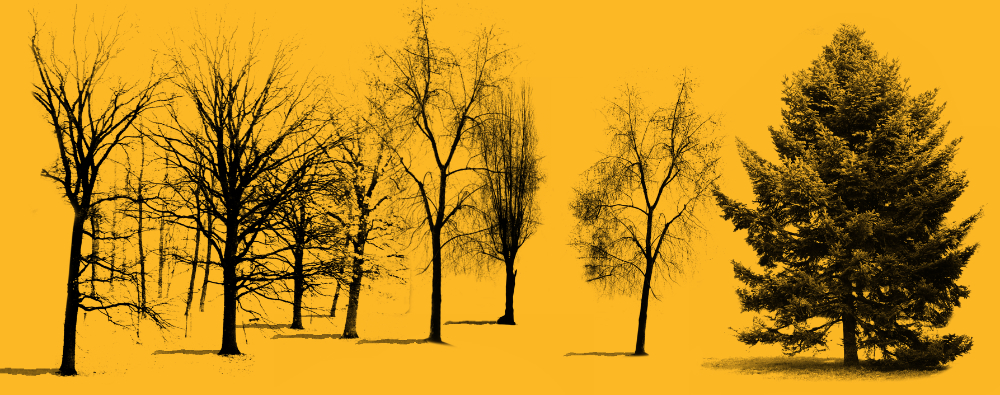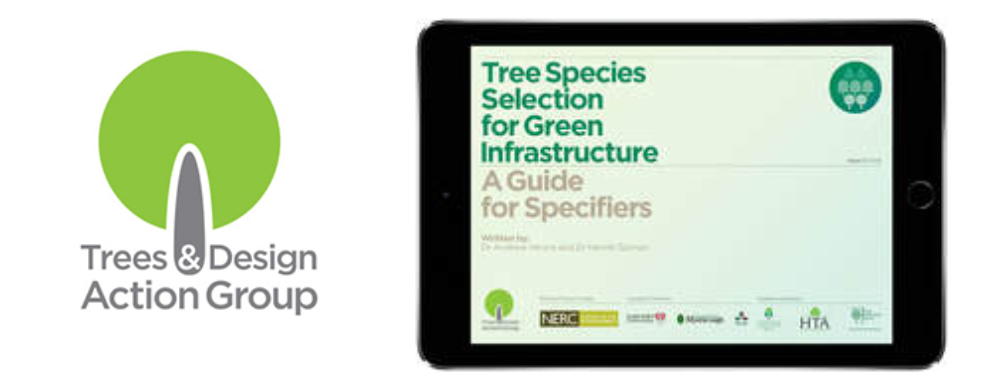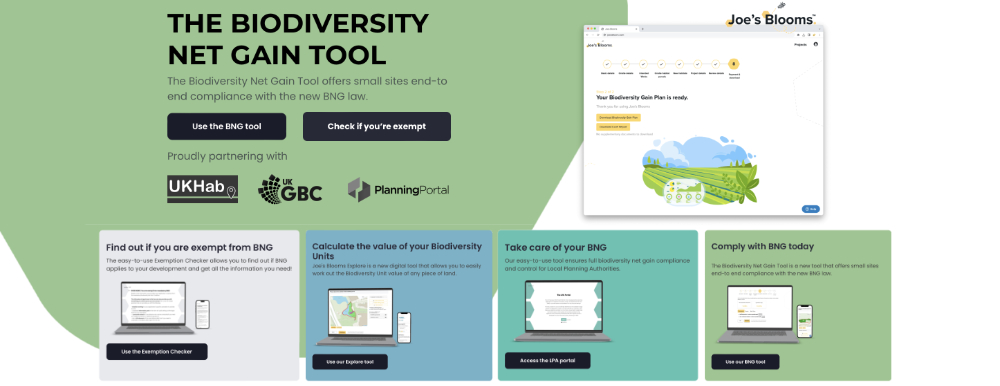Guidance on tree specification, BNG and more
[edit] Selecting trees
Tree specification is the process of selecting and describing certain specific characteristics that might be required of a tree for a specific site, such as, for example, deciduous or evergreen, the canopy shape and form, growing height, durability, maintenance requirements, root depth, etc. It is usually a process that leads to the specification of a particular tree species at a certain age with certain planting requirements and can often require specialist input.
[edit] Biodiversity Net Gain (BNG)
Biodiversity Net Gain (BNG) became mandatory for major developments on February 12, 2024, and for small sites or minor developments from April 2, 2024, Nationally Significant Infrastructure Projects is planned from 2025. Meeting the requirements may well involve the process of tree specification, now for both large and small developments.
A minor residential development is defined as one to nine dwellings, inclusive, on a site having an area of less than one hectare, or, where the number is not known, a site area of less than 0.5 hectares. For non-residential, where the floor space to be created is less than 1,000 square metres or where the site area is less than one hectare. Developments that exceed this, so 10 dwellings or more, are defined as major developments, with these exemptions; development impacting a habitat area below 25 m2 or 5m for linear habitats such as hedgerows, householder planning applications, and small scale self-build custom buildings.
Biodiversity Net Gain (BNG) is based on the statutory biodiversity metric of biodiversity units (area, hedgerow, and watercourse units) that need to be calculated prior to a development taking place, along with how many units are needed to replace units of habitat lost through the development. Developers need to achieve a 10% BNG through the creation or enhancement of habitats to be evidenced via a biodiversity gain plan, which can be submitted to the local planning authority after the planning application has been approved.
The assessment needs to be carried out by a professional ecologist, according to the guidance and in line with any Local Nature Recovery Strategy (LNRS), and the biodiversity improvements are then recorded in the publicly available biodiversity gain site register. The approach taken to biodiversity protection is referred to as the mitigation hierarchy.
[edit] Tree specification guidance
Tree specification can be particularly important in urban areas where constraints, such as space restrictions, climatic requirements, or maintenance regimes, can reduce the number of suitable species.
Trees may be planted individually or as part of a design or landscape concept and described with terms such as urban treescape, urban forests, green infrastructure, blue green infrastructure, urban planting, green network, green corridor, green belt, natural capital, biodiversity infrastructure, biodiversity net gain, and so on.
To assist urban planners, architects,designers, and those engaged with the built environment in selecting the correct tree types for specific project needs, there are a number of guidance documents available specifically for the UK as well as internationally
[edit] Tree species selection for green infrastructure: A guide for specifiers
Tree species selection for green infrastructure: A guide for specifiers, offers, for the first time in the UK, a comprehensive, research-based decision-making tool for selecting appropriate species for a range of planting scenarios. It helps improve species selection so that towns and cities can have a diverse and resilient palette of trees that are capable of thriving in challenging urban environments.
The guide has been produced by The Trees and Design Action Group (TDAG), which brings together individuals, professionals, academics, and organisations from wide-ranging disciplines in both the public and private sectors to improve knowledge and good practice to support the role of urban trees through better collaboration in the planning, design, construction,management, and maintenance of our urban places.
The guide and its companion database are available at https://www.tdag.org.uk/tree-species-selection-for-green-infrastructure.html.
[edit] Urban Tree Manual
The Urban Tree Manual was produced for Defra by the Forestry Commission, England, with expert inputs from Forest Research, the Animal and Plant Agency, the University of Birmingham, and the Royal Horticultural Society. It provides advice on selecting and procuring the right tree for the right place in urban areas. It also highlights the long-term issues of the threats to existing trees from pests, disease, and climate change and describes the benefits to the environment and wellbeing that urban trees can provide. It is not intended as an exhaustive compendium on tree selection, aftercare,and management. Instead, it presents current thinking on these matters and provides valuable signposting to further relevant information. It is useful for anyone involved in planting trees in towns and cities but is primarily aimed at local authorities, charities, community groups, and land owners.
For further information visit https://www.forestresearch.gov.uk/tools-and-resources/fthr/urban-tree-manual/
[edit] Tree species handbook, A technical guide for practitioners
The tree species handbook, A technical guide for practitioners is produced by the Woodland Trust, the UK's largest woodland conservation charity. The handbook aims to help with decisions about tree species in woodland creation projects, with profiles of 50 tree and shrub species and 18 woodland communities. It seeks to ensure that species are well matched to the location and conditions of the site and that trees establish themselves in structures and communities where they thrive and can best contribute to nature recovery and ecological resilience. The species profiles give an overview of their ecology and associated wildlife, scores for tolerances, maps to guide where each might be most appropriate, how each can feature in different woodland structures, as well as how they disperse and establish to inform decisions about planting, seeding, and natural colonisation.
The handbook accompanies the woodland creation guide, For further information visit https://www.woodlandtrust.org.uk/publications/2022/03/tree-species-handbook/
[edit] Joe's Blooms BNG online tools
From April 2024 in the UK, large and small sites need to comply with the Biodiversity Net Gain (BNG) rules. The Biodiversity Net Gain Tool is a simple-to-use, end-to-end digital service that allows small site developers to create best-in-class Biodiversity metric sheets and Biodiversity Gain Plans. Comply with the new BNG rules online, and with confidence.
Designed for property developers, consultants, contractors, ecologists, planners and architects.
For further information visit https://www.joesblooms.com/
[edit] The Arbor Day Foundation Tree Guide
The Tree Guide gives in-depth knowledge on over 200 trees, such as height, spread and soil requirements. It is produced by the Arbor Day Foundation, founded in 1972, the world’s largest member nonprofit dedicated to planting trees. The network is made up of a diverse group of individuals, municipalities, corporations, and planting organisations that enable tree planting around the world. In over 50 years the foundation has helped plant more than 500 million trees in neighbourhoods and forests across more than 50 countries. Other guidance includes the tree benefits calculator, tree classifications and the tree glossary.
For further information visit https://www.arborday.org/trees/treeguide/
[edit] Urban Tree Selection Guide. US
This Urban Tree Selection Guide provides key information for selecting trees suitable for landscapes in the urban Mid-Atlantic US, including Maryland, Delaware, Pennsylvania, Virginia and the parts of New Jersey, New York and North Carolina that drain into related waterways of the central region. Trees are first grouped by size at maturity, then alphabetically by scientific name. Each row provides information about the tree, including its growing conditions, physical characteristics, habitat indicators and recommended landscape locations.
[edit] Ecosia.org
Although not a tree guide specifically Ecosia.org is an online search engine that plants trees in return for the internet searches that are made. It was founded in 2009 by Christian Kroll after a trip around the world exposed him to the environmental and social impact of deforestation. The organisation uses all of its profits for climate action, with the majority going into tree-planting projects. It produces transparent monthly reports of its accounts alongside tree-planting projects, and investments in solar energy.
For further information visit https://www.ecosia.org/?c=en
[edit] Related articles on Designing Buildings
- Biodiversity.
- Biodiversity net gain and related terminologies explained.
- Ecosystem.
- Ecology connectivity.
- Green belt.
- Green infrastructure.
- Green network.
- Green roof.
- Growing space.
- Habitat.
- Helping to make Europe a wilder place.
- How green infrastructure is helping to control urban floods.
- Living Roofs and Walls, from policy to practice.
- The future of green infrastructure.
- Trees.
- Timber vs wood.
- Timber.
- Tree dripline.
- Tree hazard survey.
- Tree planters and tree pits.
- Tree preservation order.
- Tree rights.
- Tree root subsidence.
- Trees in conservation areas.
Featured articles and news
Government consultations for the summer of 2025
A year of Labour, past and present consultations on the environment, the built environment, training and tax.
CMA competitiveness probe of major housing developers
100 million affordable housing contributions committed with further consultation published.
Homes England supports Greencore Homes
42 new build affordable sustainable homes in Oxfordshire.
Zero carbon social housing: unlocking brownfield potential
Seven ZEDpod strategies for brownfield housing success.
CIOB report; a blueprint for SDGs and the built environment
Pairing the Sustainable Development Goals with projects.
Types, tests, standards and fires relating to external cladding
Brief descriptions with an extensive list of fires for review.
Latest Build UK Building Safety Regime explainer published
Key elements in one short, now updated document.
UKGBC launch the UK Climate Resilience Roadmap
First guidance of its kind on direct climate impacts for the built environment and how it can adapt.
CLC Health, Safety and Wellbeing Strategy 2025
Launched by the Minister for Industry to look at fatalities on site, improving mental health and other issues.
One of the most impressive Victorian architects. Book review.
Common Assessment Standard now with building safety
New CAS update now includes mandatory building safety questions.
RTPI leader to become new CIOB Chief Executive Officer
Dr Victoria Hills MRTPI, FICE to take over after Caroline Gumble’s departure.
Social and affordable housing, a long term plan for delivery
The “Delivering a Decade of Renewal for Social and Affordable Housing” strategy sets out future path.
A change to adoptive architecture
Effects of global weather warming on architectural detailing, material choice and human interaction.
The proposed publicly owned and backed subsidiary of Homes England, to facilitate new homes.
How big is the problem and what can we do to mitigate the effects?
Overheating guidance and tools for building designers
A number of cool guides to help with the heat.
The UK's Modern Industrial Strategy: A 10 year plan
Previous consultation criticism, current key elements and general support with some persisting reservations.
Building Safety Regulator reforms
New roles, new staff and a new fast track service pave the way for a single construction regulator.






























